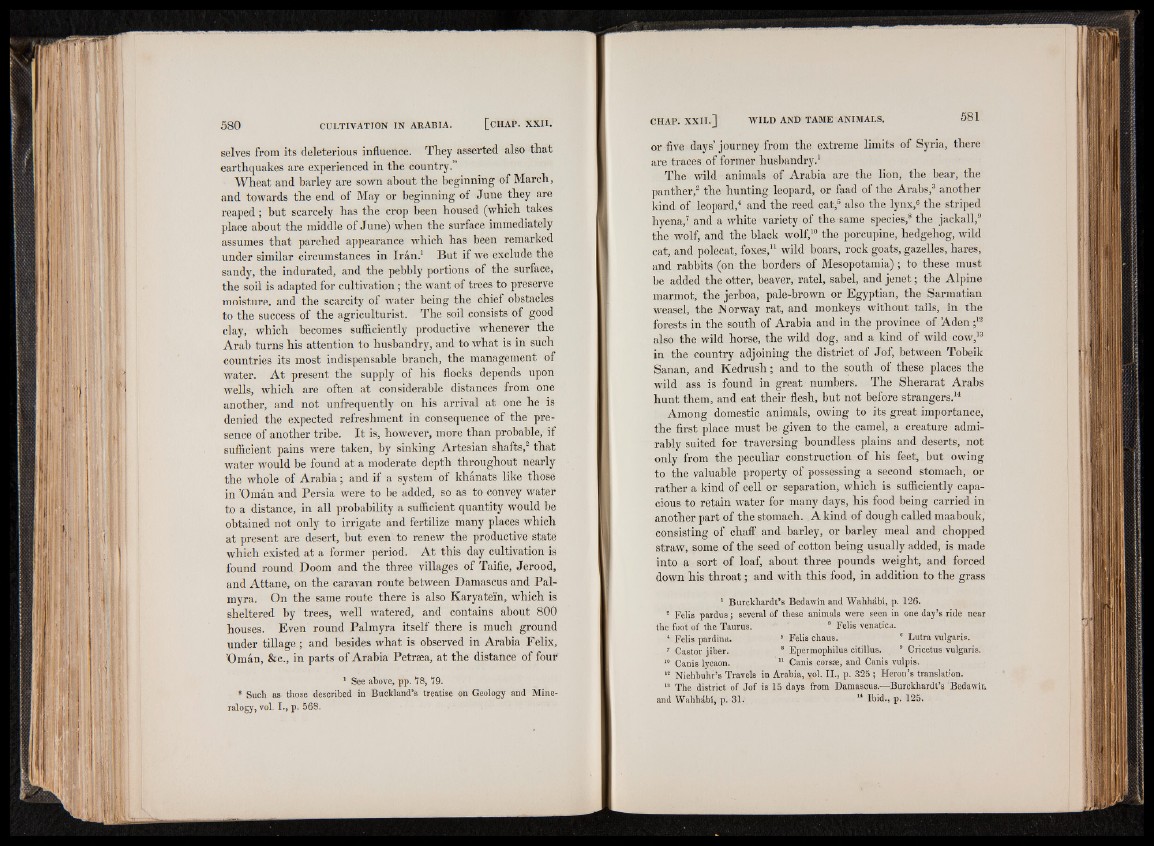
selves from its deleterious influence. They asserted also that
earthquakes are experienced in the country.”
Wheat and barley are sown about the beginning of March,
and towards the end of May or beginning of June they are
reaped; but scarcely has the crop been housed (which takes
place about the middle of June) when the surface immediately
assumes that parched appearance which has been remarked
under similar circumstances in Irán.1 But if we exclude the
sandy, the indurated, and the pebbly portions of the surface,
the soil is adapted for cultivation; the want of trees to preserve
moisture, and the scarcity of water being the chief obstacles
to the success of the agriculturist. The soil consists of good
clay, which becomes sufficiently productive whenever the
Arab turns his attention to husbandry, and to what is in such
countries its most indispensable branch, the management of
water. At present the supply of his flocks depends upon
wells, which are often at considerable distances from one
another, and not unfrequently on his arrival at one he is
denied the expected refreshment in consequence of the presence
of another tribe. It is, however, more than probable, ii
sufficient pains were taken, by sinking Artesian shafts*2 that
water would be found at a moderate depth throughout nearly
the whole of Arabia; and if a system of khánats like those
in ’Omán and Persia were to he added, so as to convey water
to a distance, in all probability a sufficient quantity would be
obtained not only to irrigate and fertilize many places which
at present are desert, but even to renew the productive state
which existed at a former period. At this day cultivation is
found round Doom and the three villages of Taifie, Jerood,
and Attane, on the caravan route between Damascus and Palmyra.
On the same route there is also Karyateln, which is
sheltered by trees, well watered, and contains about 800
houses. Even round Palmyra itself there is much ground
under tillage ; and besides what is observed in Arabia Felix,
’Omán, &c., in parts of Arabia Petrsea, at the distance of four
1 See above, pp. 78, 79.
2 Such as those described in Buckland’s treatise on Geology and Mineralogy,
vol. I., p. 568.
or five days’ journey from the extreme limits of Syria, there
are traces of former husbandry.1
The wild animals of Arabia are the lion, the hear, the
panther,2 the hunting leopard, or faad of the Arabs,3 another
kind of leopard,4 and the reed cat,6 also the lynx,6 the striped
hyena,7 and a white variety of the same species,8 the jackall,9
the wolf, and the black wolf,10 the porcupine, hedgehog, wild
cat, and polecat, foxes,11 wild boars, rock goats, gazelles, hares,
and rabbits (on the borders of Mesopotamia); to these must
be added the otter, beaver, ratel, sabel, and jenet; the Alpine
marmot, the jerboa, pale-brown or Egyptian, the Sarmatian
weasel, the Norway rat, and monkeys without tails, in the
forests in the south of Arabia and in the province of Aden ;12
also the wild horse, the wild dog, and a kind of wild cow,13
in the country adjoining the district of Jof, between Tobeik
Sanan, and Kedrush; and to the south of these places the
wild ass is found in great numbers. The Sherarat Arabs
hunt them, and eat their flesh, but not before strangers.14
Among domestic animals, owing to its great importance,
the first place must be given to the camel, a creature admirably
suited for traversing boundless plains and deserts, not
only from the peculiar construction of his feet, but owing
to the valuable property of possessing a second stomach, or
rather a kind of cell or separation, which is sufficiently capacious
to retain water for many days, his food being carried in
another part of the stomach. A kind of dough called maabouk,
consisting of chaff and barley, or barley meal and chopped
straw, some of the seed of cotton being usually added, is made
into a sort of loaf, about three pounds weight, and forced
down his throat; and with this food, in addition to the grass
1 Burckhardt’s Bedawin and Wahhabi, p. 126.
8 Felis pardus; several of these animals were seen in one day’s ride near
the foot of the Taurus. ' 8 Felis venatica.
* Felis pardina. 6 Felis chaus. 8 Lutra vulgaris.
7 Castor jiber. 8 Epermophilus citillus. 9 Cricetus vulgaris.
19 Canis lycaon. 11 Canis corsse, and Canis vulpis.
18 Niehbuhr’s Travels in Arabia, vol. II., p. 325 ; Heron’s translation.
13 The district of Jof is 15 days from Damascus.—Burckhardl’s Bedawin
and Wahhdbi, p. 31. 11 Ibid., p. 125.